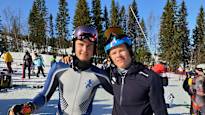With the beginning of the winter sports season, the intention of the Ski Federation to collect a maximum of 500 euros from the athletes selected for the World Cups for each World Cup weekend became a significant topic of conversation.
Of the national team’s top athletes, for example Johanna Matintalo commented on the matter to Urheilu rather bitterly.
If a skier or ski jumper went around all the World Cups, deductibles would accumulate around 6,000 euros; in combined, the number of competitions is smaller.
However, everything is relative. The co-payments of the Nordic sports operating under the Ski Association are a pittance when compared to the tariffs of Ski Sport Finland, which runs the national alpine skiing team.
– The season costs 25,000–30,000 euros, says the 20-year-old Jesperi Kemppainenwho in the starting season belongs to the five-man C national team.
Six athletes were selected for the women’s C national team for this season. Women are coached by the head coach Johanna Tikkanenmen Austrian Mario Rafetzer.
Only one athlete in the A national team
It is about the co-responsibility part defined in the sports association Ski Sport Finland’s athlete contract, of which the coaching fees account for about 8,500 euros and the rest for other expenses, which in a sport like alpine skiing are very high.
In the B national team of a total of five athletes, the deductibles are about a third smaller. As an A-category athlete the sports association named only speed sports expert for the 2024–25 season Elian Lehtonwho trains and works in the Swiss national team milieu. The sport association offsets a part of the costs of the cooperation pattern, i.e. the so-called purchase national team place, and the partners of the country’s number one scorer cover a part.
Just like in the Ski League, the athlete’s expenses in Ski Sport Finland are increased by the fact that everyone pays for all trips to Helsinki-Vantaa airport and home from there. Winter athletes rarely live in the capital region.
– Including this, the price for the season will be well over 30,000 euros, says Kemppainen, who finished his conscript service at the Santahamina Sports School in Helsinki on Thursday.
The CEO of Ski Sport Finland, who was contacted after the FIS congress in Zurich Janne Leskinen admits the numbers told by Jesperi Kemppainen as correct.
“There is no state of will”
– The levels are of that category. Deductibles are big. It is by no means the will of Ski Sport Finland, but the current economic realities dictate the situation.
According to Leskinen, a significant drop in deductibles was discussed in the association, but according to the CEO, it would have happened at the expense of quality.
– In principle, a very low deductible could be levied, but it is a different matter whether it would be possible to resource such coaching and other activities afterwards that it would be reasonable and meaningful for anyone. It was decided that it would be better to do it properly, Ski Sport Finland will pay according to their ability and the athletes will pay the rest.
When Finnish alpine skiing Tanja Poutiainen-Rinne and Kalle Palander at the beginning of the 2000s, i.e. at its peak, according to Leskinen, deductibles were not collected in practice:
– And even now we are trying to get rid of them. Deductibles are compensated to the athletes by allowing them to sell part of the visibility of the competition outfit to their own partners.
Kemppainen, who receives about a third of his season budget from his own sponsors, and thanks his parents profusely for their support, emphasizes that he is not complaining or protesting the situation. It has always been clear to the high school student from Rovaniemi last spring that the pursuit of the top in alpine skiing is very expensive.
– I have never regretted that I made such a sport choice, says the young man, who in the beginning season is aiming for good placings in the competitions of the European Cup, i.e. the lower division of the World Cup.
Kemppainen also knows of cases where alpine skiing careers have ended right on the threshold of national team status, at least largely for financial reasons.
“Sports card until the end”
In the 2025–26 season, Kemppainen will try to start the upper category, i.e. as a scorer at the B national team level. Among other things, sports are now played at that level Eduard Hallbergwhose fighter partner Kemppainen just joined the army.
– I’m going to look at the sports card until the end now and I didn’t accept any place at an educational institution, even if I got several.
Janne Leskinen states that it is not at all unusual in the world of alpine skiing that young newcomers have to pay for their lower category national team places in one way or another. One common way is to pay the association a commission from the amount that you can collect from your own advertising space for the competition outfit.
– Then Switzerland, Austria and Italy wrestled in their own series, already through the fact that the sport’s best means of generating income are its own World Cup competitions.
These alpine sports giants will organize 11 World Cup events for men and 10 for women in the season that is starting.
Jesperi Kemppainen says that he has been following the media coverage of the Ski Federation’s deductibles.
– I am a little surprised that payments would also be taken from these star athletes, who have certainly brought in quite a lot of money for the association over the years.
